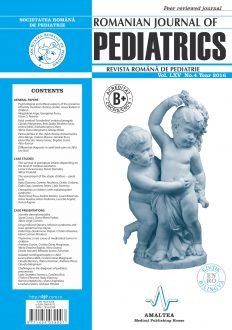SELECT ISSUE

Indexed

| |

|
|
|
| |
|
|
|

|
|
|
|
|
|
|
HIGHLIGHTS
National Awards “Science and Research”
NEW! RJP has announced the annually National Award for "Science and Research" for the best scientific articles published throughout the year in the official journal.
Read the Recommendations for the Conduct, Reporting, Editing, and Publication of Scholarly work in Medical Journals.
The published medical research literature is a global public good. Medical journal editors have a social responsibility to promote global health by publishing, whenever possible, research that furthers health worldwide.
THE SURVIVAL OF PREMATURE INFANTS DEPENDING ON THE LEVEL OF MEDICAL ASSISTANCE
Larisa Crivceanscaia, Maria Stamatin and Mihai Stratulat
ABSTRACT
Worldwide, premature birth is the main cause of infant mortality and a significant cause of human potential loss of premature survivors for the next stages of life.
Purpose. To determine the rate of premature infants survival depending on the level of medical assistance and the main risk factors involved in the death of preterm infants with gestational age less than 34 weeks.
Materials and methods. We included in the study 750 preterm newborns divided into three groups as follows: group 1 – 476 premature newborns born in IMSP IMsC, Chisinau (level III maternity); group 2 – 240 premature infants transferred by the AVIASAN service from level I and II maternities to the level III unit and group 3 – 34 premature babies from IMSP IMsC Chisinau that received surfactant administered by the LISA method (Less Invasive Surfactant Administration). We performed a complex analysis of the risk factors for death and the positive impact of highly specialised care on survival. The data was analysed using SPSS V.21 software (IBM Statistical Package for the Social Sciences, Chicago, Illinois).
Results. The survival rate at 78 days of life was significantly higher in the newborns from the level III maternity that received LISA therapy (93.3%), compared to those in group 1 (78.2%) and group 2 (78.9%) respectively.
Conclusions. The survival of premature infants is a multifactorial problem. The main factor that determines the rate of death for these infants is respiratory distress syndrome (RDS), followed by birth weight (BW), gestational age (GA), resuscitation method, bronchopulmonary dysplasia (BPD) and last but not least by the level of maternity where the infants were born. These factors might be considered predictive for death of preterm newborns with gestational age less than 34 weeks.
Keywords: newborn, survival, mortality, premature
Full text | PDF
